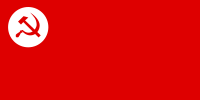Revolutionary Socialist Party (India)
|
Revolutionary Socialist Party
|
|
|---|---|
| Secretary-General | T. J. Chandrachoodan |
| Founded | 1940 |
| Headquarters | 17, Firoz Shah Road, New Delhi – 110001 28°37′20.5″N 77°13′27.9″E / 28.622361°N 77.224417°E |
| Youth wing | Revolutionary Youth Front |
| Ideology |
Communism Socialism Marxism–Leninism |
| Political position | Left-wing |
| Colours | Red |
| ECI Status | State Party |
| Alliance | United Democratic Front (2014-Present) |
| Seats in Lok Sabha |
1 / 545
|
| Election symbol | |
 |
|
| Website | |
| rsp.org.in | |
Revolutionary Socialist Party (RSP) is a Marxist–Leninist political party in India. The party was founded on 19 March 1940 and has its roots in the Bengali liberation movement Anushilan Samiti and the Hindustan Socialist Republican Army. The party got around 0.4% of the votes and three seats in the Lok Sabha elections in 1999 and 2004. It is part of the state government in Tripura (as of June 2011).
A major section of the Anushilan movement had been attracted to Marxism during the 1930s, many of them studying Marxist–Leninist literature whilst serving long jail sentences. A minority section broke away from the Anushilan movement and joined the Communist Consolidation, and later the Communist Party of India. The majority of the Anushilan Marxists did however, whilst having adopted Marxist–Leninist thinking, feel hesitant over joining the Communist Party.
The Anushilanites distrusted the political lines formulated by the Communist International. They criticised the line adopted at the 6th Comintern congress of 1928 as 'ultra-left sectarian'. The Colonial theses of the 6th Comintern congress called upon the communists to combat the 'national-reformist leaders' and to 'unmask the national reformism of the Indian National Congress and oppose all phrases of the Swarajists, Gandhists, etc. about passive resistance'. Moreover, when Indian left-wing elements formed the Congress Socialist Party in 1934, the CPI branded it as Social Fascist. When the Comintern policy swung towards Popular Frontism at its 1935 congress, at the time by which the majority of the Anushilan movement were adopting a Marxist–Leninist approach), the Anushilan Marxists questioned this shift as a betrayal of the internationalist character of the Comintern and felt that the International had been reduced to an agency of Soviet foreign policy. Moreover, the Anushilan Marxists opposed the notion of 'Socialism in One Country'.
...
Wikipedia

